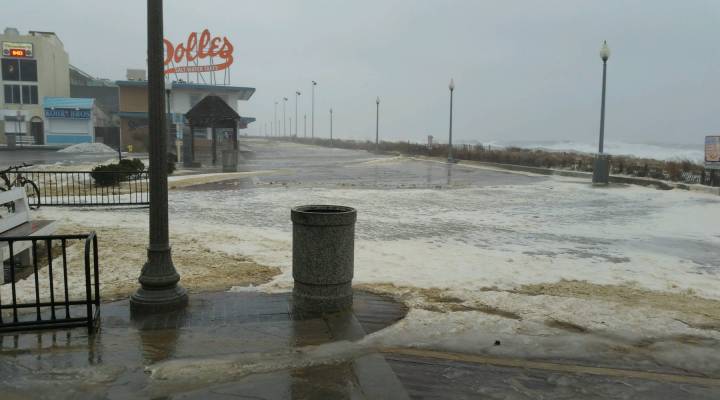
Delaware’s rebuilt dunes did the job, but now are gone

A 16-foot dune used to stand at the north end of the boardwalk in Rehoboth Beach, Delaware. But in October, a nor’easter came along and bit off a few feet. And then a stronger storm in January demolished the rest.
“Yeah, it’s going to take a while to get all of this straightened out,” said William Frazier, a maintenance worker.
A couple days after the storm, Frazier and two other workers were shoveling sand from the boardwalk onto the beach below. Sand covered the entire boardwalk. Fragments of fences lay crumpled along the beach. Vegetation was uprooted and strewn about.
Delaware’s senior U.S. Senator, Tom Carper, said this is what storm protection looks like. “The damage isn’t to the boardwalk,” he said. “The damage is not to businesses, to the homes, not to the streets. It’s to the beach or the dune. Which have done their job.”
In the weeks since, officials did find damage to bridges, boardwalks, homes and businesses. On February 18, Governor Jack Markell wrote to President Obama, asking for more than $2.5 million to help.
The destruction worries Tony Pratt, the shoreline administrator for Delaware’s Department of Natural Resources and Environmental Control. He fears what will happen if another major storm comes along before communities can regroup.
“We’ll be in even worse conditions, because then we’ll have hardly any dune left,” Pratt said.
The Army Corps of Engineers has plans to repair dunes along a couple of the beaches later this year, but projects in some of the really battered areas won’t start until after the winter of 2017.
Since the early 2000s, more than $100 million in state and federal funds has been spent on building up less than seven miles of prime beachfront facing the Atlantic Ocean. Pratt says that money is well spent..
“We say the tourism that exists within Delaware’s coast is extraordinarily valuable,” he said. “If we can maintain these beaches for several more decades, we’re going to see tremendous value out of that.”
A 2012 report said Delaware’s coastal economy contributes almost $7 billion per year to the state, nearly as much as agriculture. That’s because the beaches draw so many visitors every summer.
And more of those tourists are staking out real estate claims. More seasonal homes are being constructed and bought. Recently, the value of the home rental market in the county where the most popular beaches are rose past $1 billion for the first time. And more retirees are choosing to settle down here, too.
“It goes back to the quality of our beaches, our water, the quality of life experience have when they come to Delaware’s beaches,” said Linda Parkowski, the state tourism director. “It’s a really nice area to visit and it’s very vibrant.”
But as nice as these beaches are in fair weather, they’re increasingly vulnerable to storms and rising seas.
The beach towns are well aware of these threats. That’s why many of them have changed their building codes. For example, the first floor in a new house has to be at least 18 inches higher than the flood level on FEMA’s map.
But while measures like these and building higher dunes can help protect communities now, local environmentalists believe there needs to be a better long-term, less costly strategy to defend the beaches from storm damage.
Coastal scientist Art Trembanis at the University of Delaware said the way officials address the public after extreme weather has become like a broken record.
“There’s often a quick response to say, ‘hey we did it, we survived in these places. And this defense system survived,'” Trembanis saud. “And that’s great, and that’s testament to the fine engineering work that goes into those different defenses, but it’s a bit like celebrating surviving the first round of a title fight with Mike Tyson.”
Tony Pratt at the Department of Natural Resources knows that eventually, it will become more expensive to maintain the beaches than they’re worth. But for now, this is all they can do.
“Until that tipping point, we’re going to keep doing what we’re doing,” he said.
Though it’s not certain yet how the state will pay for the dune repairs this year.
There’s a lot happening in the world. Through it all, Marketplace is here for you.
You rely on Marketplace to break down the world’s events and tell you how it affects you in a fact-based, approachable way. We rely on your financial support to keep making that possible.
Your donation today powers the independent journalism that you rely on. For just $5/month, you can help sustain Marketplace so we can keep reporting on the things that matter to you.


















